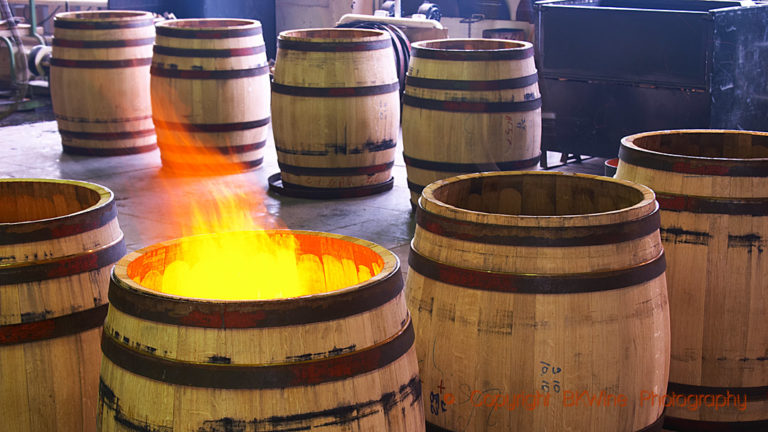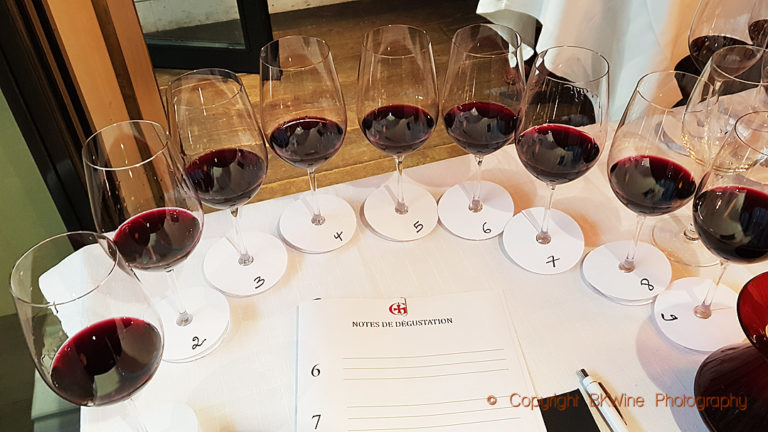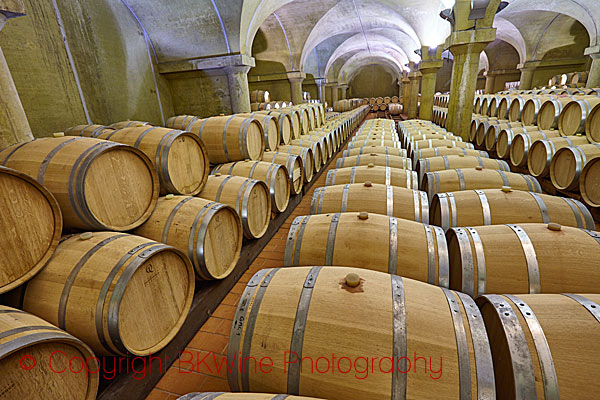Text: David Furer
Photo: Per Karlsson / BKWine & David Furer
Copyright © David Furer & BKWine
With the rise of flavor profiles attributed to French wood, along with their undisputed preeminence in technique, the dominance of French cooperages in fine wines in the past 20 or so years has led to a type of myopia for French oak barrels within the international wine community. French cooperages aren’t yet running scared but with greater domestic interest in locally-grown and -produced oak barrels this might change.
The double-digit growth of German wine sales in the US could also prove a positive influence in this trend. Continental northern Europe, saved from the deforestation suffered by the once poverty-stricken Mediterranean areas, have provided its inhabitants endless sources of oak (and other trees) for barrel-making. Orders at French coopers, along with the odd order from the US, continue to rise Germany, Hungary, Spain, and other countries are increasing, but production of locally-fashioned barrels for its native wines are increasing.
Germany
Compared to US forests which are subject to relatively little government regulation, Germany’s sizable forests are strictly managed by its states with controls that apply equally to both public and private forests. “The difficulty in Germany,” says its first Master Sommelier Frank Kämmer, “is not a lack of wood but a lack of coopers. It’s an open secret that German oak logs are sold to French coopers both by private growers and by the states of Rheinland-Pfalz, Hesse, and Baden-Württemberg.” Kämmer provided a quote from a 1936 German winemaking text written by Dr. Karl Becker, lecturer of Weinbauschule Trier, clearly stating that “the better and more powerful red wines…are being aged in smaller vats (200 to 300 liters).” As importation of wood from other countries was anathema at this time, we may assume the provenance of the barrels in question to be German. (Photo: some winemakers make extensive use of oak. Here: Guigal.)
Karl Schanz of Mössingen, a village south of Stuttgart, was one of the last traditional coopers in Germany. For 150 years his family sourced oak from the local Schwäbische Alb forest. Due to the predominance of nutrient poor, sandy soil along with the harsh climate of this region, oak trees are grown very slowly and possess relatively narrow annual rings—necessary to insure minimal porosity in the finished barrels. In research tests, this Swabian oak was shown to be similar in style to that of France’s Allier. Schanz thinks the quality of craftsmanship trumps the source of the oak.
Schanz’ sentiment is echoed by sales manager Frank Schuber of the Rheingau’s Schloss Johannisberg and G.H. von Mumm wineries. The difference here is that in 2003 Schuber and his colleagues decided to begin harvesting trees from their 260ha Schlosswald forest 180-200m high in the Taunus Mtns. and1km from the Schloss Johannisberg’s home vineyard. The trees, harvested only in December or January when dormant, are cut at a minimum of 150 years old and at a mid-tree width of 35-45cm. In order to do this a 10 year plan was required to be submitted to the Hesse state for approval.
Staves are prepared at the Hösch cooperage in Rheinhessen Hackenheim and aged outside for three years at the Mumm facility back in the Rheingau. “From 2006 on we will produce about 60 barriques for Pinots Noir and Blanc for G.H. von Mumm and about 50 stück (1200L) of neutral oak for Riesling. So far we use up to 90 year old casks for Riesling but will replace them with those sourced from the Schlosswald as they become obsolete,” says Schuber. (Photo: Aging and drying of oak staves at Château Belair in Bordeaux)
Local cooperage
One of the few surviving cooperages in Germany is Küferei Gies in the Pfalz’s Bad Dürkheim. Since 1861 current proprietor’s ancestors have been supplying local winemakers with barrels from the nearby Johanniskreuzwald. At a windy 400-450m altitude, far higher than US oak forests, this forest supplies wood ranging from 225-10, 000 liter barrels for Michael Gies’ 130 customers. He farms out the work of stave-splitting to an independent producer near the forest. Gies asserts that, “German oak gives a different taste to a wine, just as any wood will, dependent upon where it is grown and how a barrel is made.” He thinks Pfalz oak bears comparison to Allier though he admits the French wood has a smoother taste. In the face of growing consolidation of all businesses, Germany’s artisan practitioners like Gies have managed to survive by adapting. Here computers and lasers are employed to ensure accuracy and cost-efficiency.
Lathes, stave-jointing and hoop-pressing machines were purchased in 1995 to improve the barrels’ consistency. Gies thinks that the best German barrels beat that of many of the French because, he claims “the relatively fine pores of German oak hold the lower alcohol wines of Germany better than the more porous French oak. Tannin will enter the wine more slowly due to its density. Due to our colder growing period it has more fruity, less vanilla flavors.” Based upon this knowledge US wine producers wishing to create greater fruit intensity over oakiness would be advised to seek these qualities out in barrels both from Germany and from elsewhere. (Photo: “Toasting” of barrels at a cooperage)
Two of Gies’ local customers are celebrated Pfalz winemakers Rainer Lingenfelder and Werner Knipser. Knipser, famous in Germany for his pioneering use of new oak and once a customer of Schanz, buys 15% of his barrels from Gies. “It’s not that I want to flavor my wines with oak but to increase their capacity to age in the bottle.” He believes that scientific analysis to determine quality isn’t useful and that empirical testing is crucial. “German oak is grown slowly with staves of 30mm width as opposed to 22-27mm in France.” Rainer Lingenfelder has moved completely from using French to Gies’ German oak since 1996 having used Pfalz oak since 1993. “We’re beyond the experimentation period; we’re convinced that good German barrels show the ‘heritage’ of our wines better, even if it’s only based upon perception.”
Since 1974 Franken winemaker Gerhard Roth has made a name for himself as one of Germany’s visionaries of organic growing practices. Though he considered using local oak as early as 1992, he only began using Gies-made barriques with the 1999 vintage. When the wines were finished in 2001 he found them superior—fresher, richer, and fruitier–to those aged in French barriques, believing that to put a wine in a foreign barrel “puts a false influence in the wine and reflects a different structure.” Roth has taken this idea an additional step by personally harvesting 300 year old trees grown on poor soils at a windy and dry 300-450m altitude from his native Steigerwald forest according to moon phases, aging them in his village, and trucking the finished staves to the Gies cooperage where he oversees them being made into barrels. He figures that the cost of this involved process saves him 5-10% over French barrels. However, he treats this aspect of his business as a hobby and doesn’t factor in his time. (Photo (David Furer): The forest of Schloss Johannisberg.)
Hungary
Whereas their German counterparts haven’t an audience in the US, Hungarian oak is widely available here with sales growing annually. Hungarian barrel-making goes back many centuries. In centuries past the town of Gönc, which gave its name to the traditional 136-139 liter tokaji wine barrels called gönci, was crowded with cooperages. Wood for these locally-fashioned barrels was sourced from northern slopes of the Zemplen Hills on the Carpathian Mountains in the Tokaj region—15-20 miles north/northeast of the vineyards which gave the world the legendary sweet Tokaj Aszu. (Photo: Gonc and wooden carrying baskets at Oremus, Tokay.)
Istvan Turoczi, general manager of the pioneering winery Royal Tokaji Trading Company, told us that, “coopers have lived here for a long time and have a history of creating of barrels made to various sizes and shapes. The traditional gönci is quite bulgy. It was used for fermenting, aging, and transporting aszu (sweet, botrytis-affected Furmint with some Harslevelu and Muscat) wines.” Turoczi asserted that, due to a turn towards avoiding rapid oxidation, the use of gönci has quickly become anachronistic for him and his colleagues throughout the region though the stout, 200-280 liter szerednye barrels still have their place in their cellars. (Photo: Istvan Turczi of Royal Tokay Wine Company)
All wood used for barrels at RTTC is sourced from the Zemplen forest. Turoczi and I visited one of his suppliers, the nearby Dynamis cooperage in Sarospatak at the base of the Zemplen foothills. Dynamis’ owner, Erika Horcsik, estimates that at 1200 barrels/annum it’s operating at only 70% capacity. “As far as marketing goes, there are no better barrels than French. We’ve no money for marketing; our only chance is to show the world Hungarian wines at their best.” In addition to supplying wineries throughout Hungary Mrs. Horcsik also sells a few barrels to Sicily, Australia, and to Torres in Spain. Queries from north American wineries have been received with frustration as a lack of effective distribution for this small firm prevents it from currently exporting to the US.
Turoczi’s Tokaj neighbour, László Mészáros of the Disznóko estate, pointed out that, “there were more coopers in the region who disappeared during the communist regime, but now there are more again. The Zemplen hills produce excellent oak and we can now buy very high quality barrels from local coopers. But it was not the case in the beginning of the 1990s. The barrels we inherited from the State Winery were simply unusable. Our only reliable source of quality oak for our size company was France, so we aged our first aszu wines in used white Bordeaux/Sauternes barrels.”
Mészáros claims that the quality of Hungarian barrels has improved due to better selection of oak and a longer drying process. Today Disznóko sources 90% of their 1000 barrels locally. A tasting of similar wines made in different Hungarian barrels showed varying aromatic characteristics although possibly attributable to varying use of oak but, without enough of a constant, judgment must be suspended.
kn1-0012One of the more modern and internationally visible Tokaj wineries is Oremus. Oremus has its own cooperage to provide a portion of its needs as does its sibling winery in Spain’s Ribera del Duero region, the venerable Vega Sicilia. According to Purificación Mancebo, export manager for Bodegas Vega Sicilia, Vega Sicilia uses French oak barrels from Taransaud, Seguin Moreau, Radoux, Saury, and Vicard cooperages and fashions barrels of American oak by its own cooper both for Vega and its younger Duero partner Alion. “We have also some new oak plantations at Vega Sicilia of Spanish oak (quercus robur) so that in the long run we might use them for barrel making. The quercus robur is similar to the quercus alba with very low porosity and therefore allowing little microxidation,” shared Mancebo.
Local: for quality, pride or economics?
It seems that some of those interviewed express adherence to local oak not only for economic and quality reasons but also as a nod to local and/or national pride. Quality comes in many forms; local interdependence upon winemaking materials and manufacturers will help to ensure this. The curved trunks of native Californian scrub oak prevent their use for barrel-making but it’s possible to farm and harvest eastern US varieties there for wine barrel material. If these were grown upon high altitude, nutrient deficient soils above nearby vineyards, west coast winemakers could find themselves in a position to create not only a better image for themselves as stewards of the environment beyond their vineyard fencing but also further their exploration into the question of terroir while adding another marketing arrow in their quiver. Winemakers in the US Midwest can take a lesson from their German and Hungarian counterparts by exploiting the current proximity of their oak forests and coopers for the same.
(Editor’s note: Even in France there is sometimes a trend towards local sourcing. One interesting example is champagne producer Claude Giraud of Maison Giraud-Hemart. He is unusual in two ways: Firstly, oak barrels are today usually not used for aging champagne but he does it extensively. Secondly, the oak he uses is sourced in northern France, close to Champagne, instead of from the traditional oak barrel forests of Allier, Troncais etc. (Photo: Claude Giraud taking a barrel sample.)
And for those of you who might be wondering, yes, oak chips or shavings are also on the rise, both for cost reasons and because many claim, as is mentioned in David’s article that there is a risk of over-exploiting the oak forests.)
© Copyright David Furer & BKWine










